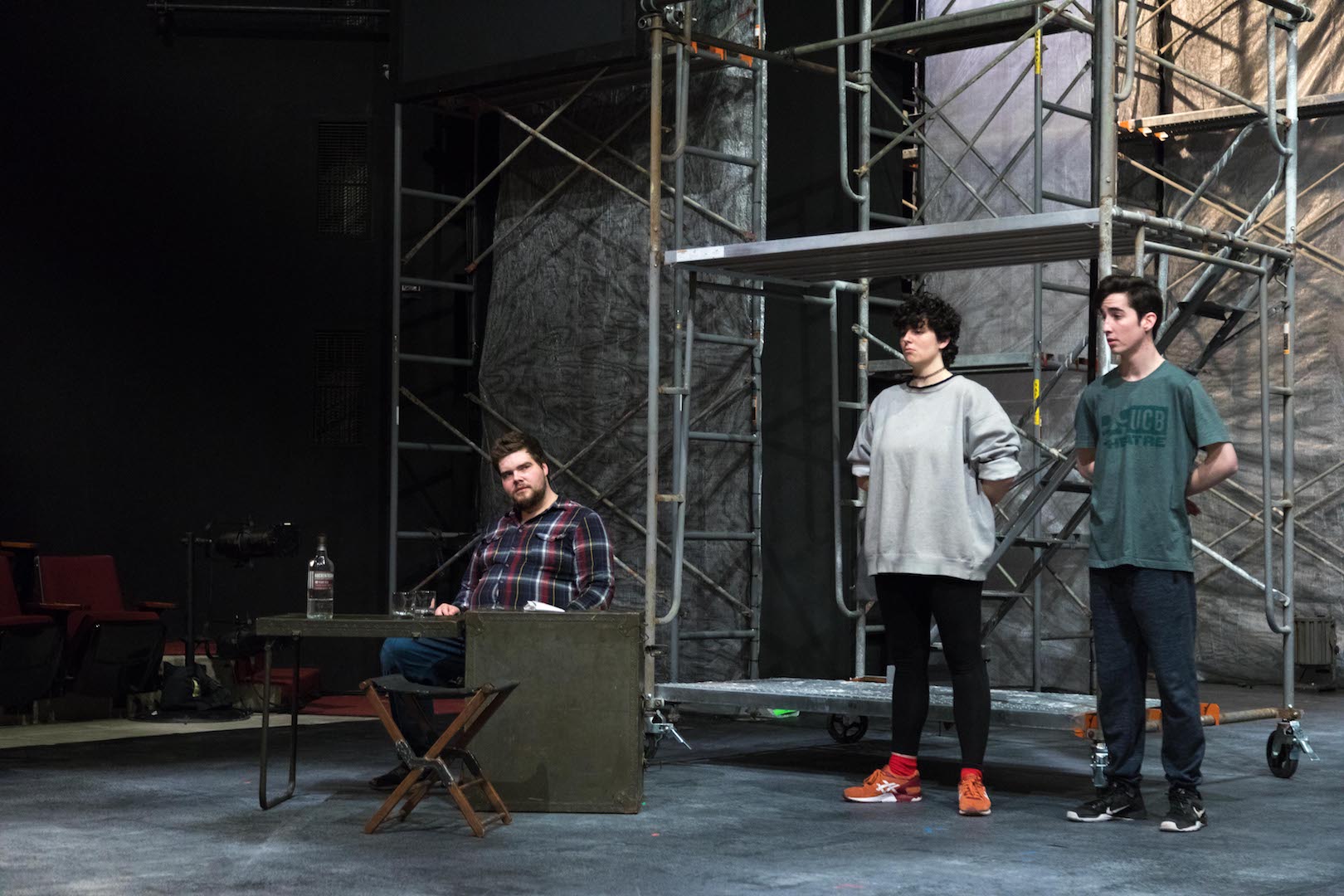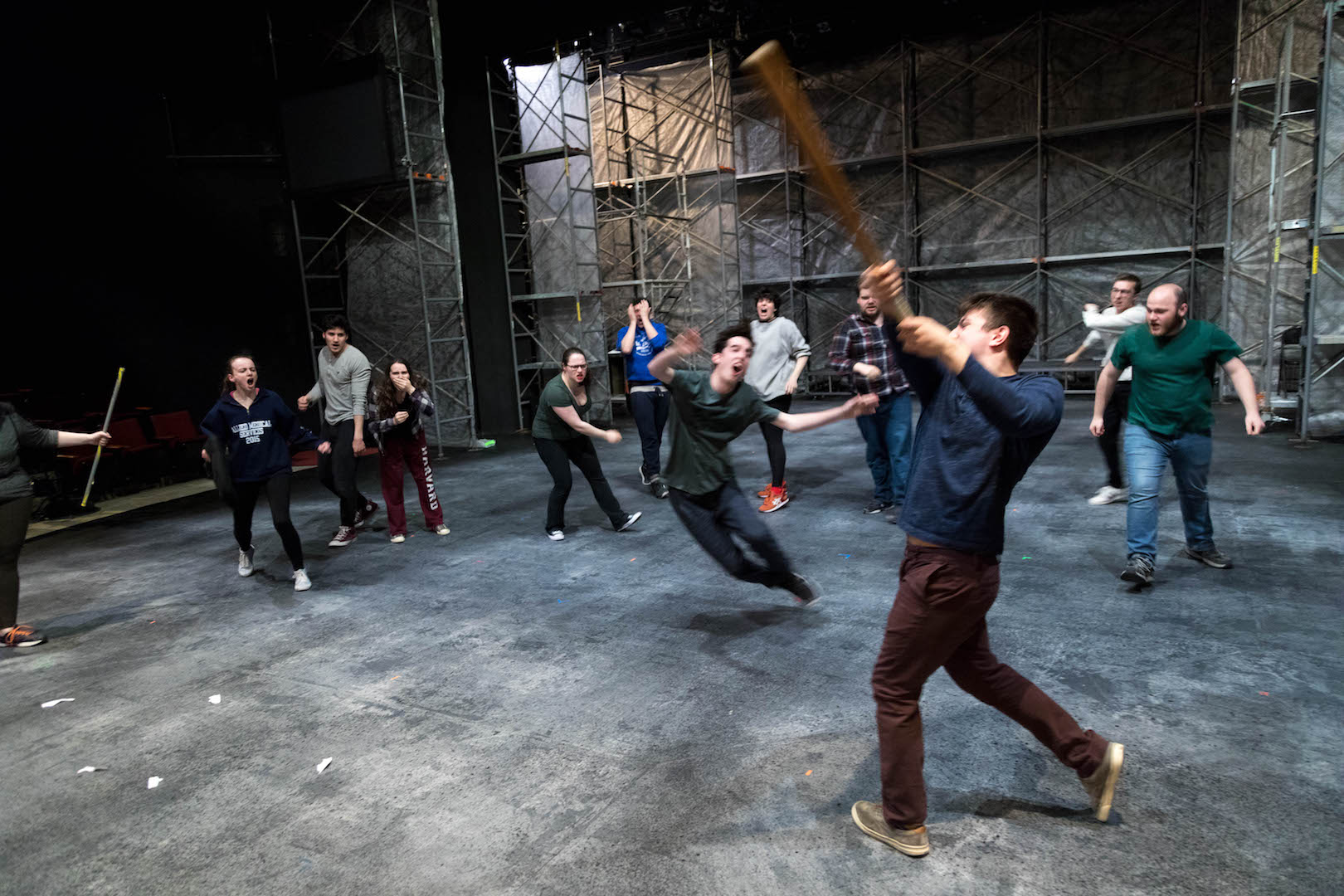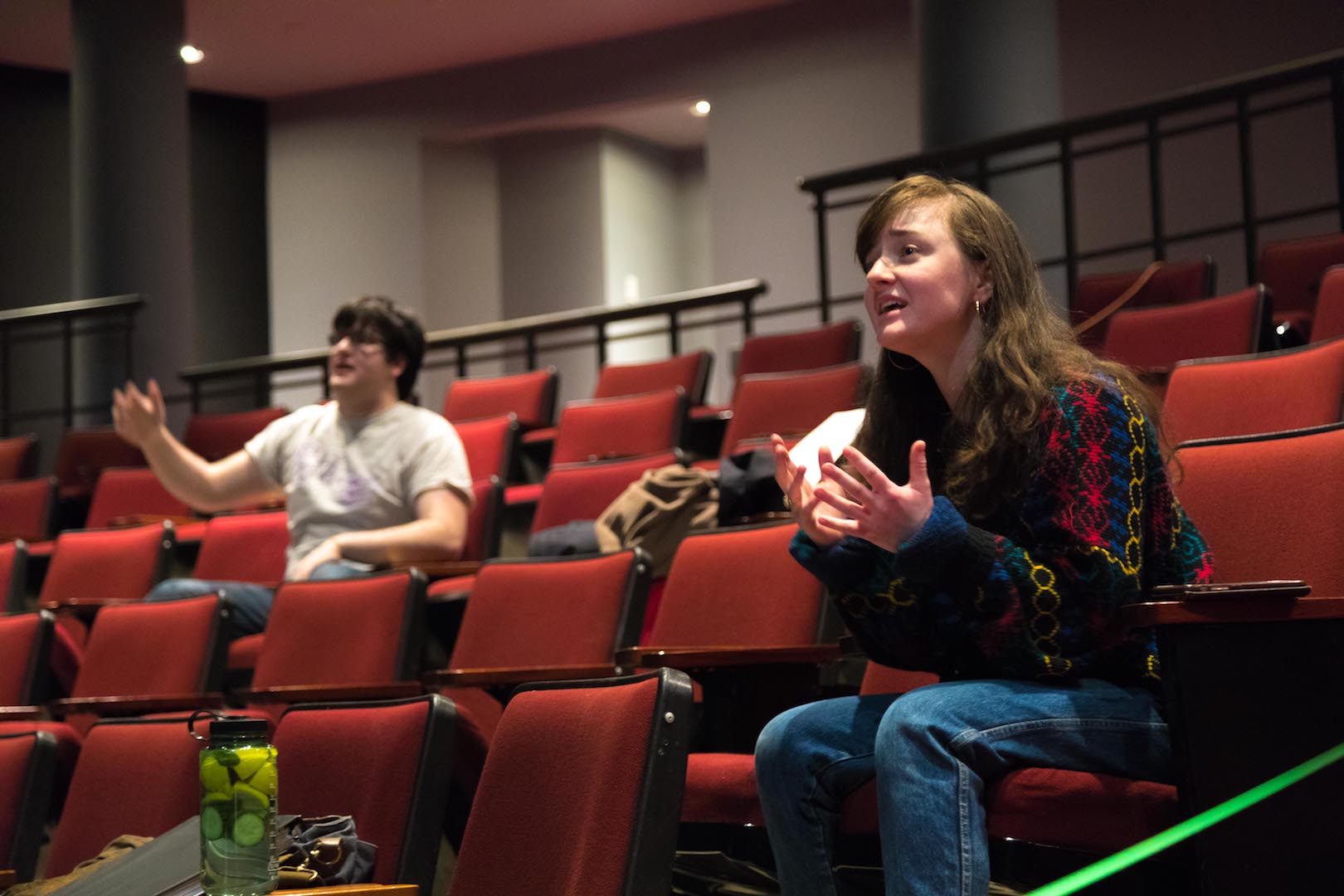By Katie Jacobsen

Photo: Dante Haughton ’19
Scattered about the Mainstage, the collection of stretching actors looks out of place amongst the towering, violently metal pieces of scaffolding. Releasing the tension in their bodies through a primal yell, the cast gets ready for one of their final rehearsals before they head into tech week. Throughout their rehearsal process, the cast has taken turns leading warm-ups, each bringing in exercises from their past theatrical experiences and/or their time abroad. Senior Anabel Milton ’18 leads today’s warm-up. After assessing where the cast was at, both physically and mentally, on this grey rainy (and snowy!) day, she decided that they could use a “calming and focusing” set of exercises. Thus commenced a twenty minute warm up filled with long stretches, fast paced tongue twisters, and a rousing three-part game called “Yes!” Off in one of the wings, the stage management team, led by Romi Moors ’18, perches on a low level of the scaffolding, preparing for the events of today’s rehearsal. They soon disband, beginning the task of adjusting the rolling pieces of scaffolding. Swinging their body weight with the grace of Tarzan flying through the trees, they try to get the looming two story pieces, the shortest of the scaffolding, to budge. Running between their stage management table, the scaffolding, and some mysterious place far off in the wings, Moors and her Assistant Stage Managers, Taylor Jaskula ’21 and Emily Hardy ’21, operate like a well-oiled machine.
I sit in on this rehearsal observing, not just as a writer for the “Living Newsletter,” but also as the production’s dramaturg. An elusive job, the dramaturg can wear many hats throughout the rehearsal process. Ask a couple of dramaturgs what they do and I guarantee you will get different answers from all of them. Our one uniting job, however, is to help the director and artistic team realize their vision for the production. We are the voices behind the historical and critical notes you see in programs, we are often the ones who lead post-show discussions, we spend time cultivating an expansive knowledge of the historical/political/philosophical aspects of the production so that we can help the production team and the actors better understand the world of the play.

Photo: Dante Haughton ’19
I came into this process back in October, when I first met with faculty director, Lary Opitz about his intention for this production. During our meeting he clued me into his vision behind choosing Julius Caesar as well as the sources he has turned to for inspiration. Accepting the position as the Spring Mainstage director, Opitz originally thought he was going to direct an original adaptation of Moby Dick. However, after witnessing America’s 2016 Presidential election and all of the ensuing political unrest, he decided now was the time to make a statement. Inspired by the Mercury Theater’s 1937 production of Caesar, directed by famous film director Orson Welles (“War of the Worlds,” “Citizen Kane”), Opitz chose to use Caesar to critique the role rhetoric plays in swaying the minds and opinions of the populous.
Caesar has been revived century after century during times of political turmoil. It was produced in 1770 at a theater in Philadelphia, PA as a way to publically criticize King George III’s treatment of the American Colonies. John Wilkes Booth played Mark Antony in a production of Caesar just months before carrying out the assassination of President Abraham Lincoln. The Royal Shakespeare Company in Stratford-upon-Avon, England set their production in contemporary Africa, drawing inspiration from Nelson Mandela’s relationship with the Complete Works of William Shakespeare, which he referred to as his “Bible” while imprisoned on Robben Island for his role in the revolution against the Apartheid in South Africa. In July 2017, a production of Caesar was done in Central Park during The Public Theatre’s “Shakespeare in the Park” series that portrayed the character of Caesar as President Donald Trump, ultimately sparking outrage and protests amongst Pro-Trump supporters.
Understanding that any production of Caesar being produced after the Public’s will incite some Trump parallels, Opitz wanted to focus on the larger picture, namely, mob mentality. Welles used the Mercury Theater’s production to compare the themes and motifs found throughout Caesar to what was happening in Fascist Italy and Nazi Germany. He accomplished this by putting pressure on what has come to be known as the “Cinna the Poet” scene. Coming just after Mark Antony’s famous speech at Caesar’s funeral in which he uses his extreme rhetorical prowess to sway the Roman citizens into sympathizing with Caesar, the scene shows audiences a young male poet who gets brutally beaten and murdered for having the same name as one of the men who conspired against Caesar. It is a scene that exemplifies how a group of people can be irrationally and violently influenced by their peers. It is a scene that Welles used to give audiences a physical, rather than an intellectual, example of what fascism was: a group of people so influenced by a politician that they murder an innocent man. Taking a page out of Welles’ book, Opitz intends Cinna the Poet to be the crux of his production.

Photo: Dante Haughton ’19
After the cast finishes their warm-ups, Assistant Director, and the show’s Fight Captain, Phillip Merrick ’19, corrals the cast for a fight call. With a quick yell of “Alright, guys! Set for scene 8!,” the cast disperses, some grabbing short sticks that are meant to resemble torches and baseball bats, others sprinting to the tops of the aisles, ready to make their entrance as a mob through the audience. There is a moment of silence and a collective breath. Merrick gives the cue, “Whenever you’re ready.” Clyne makes his entrance. The mob descends.
I had the chance to ask Merrick about the scene, and what it feels like to work so intimately with something so violent day after day. “This scene hits hard for me, ” Merrick explained. “Seeing the crowd build up in the scene before creates a unique context for the poet’s death. Though the murder looks like a senseless act of violence, we see that there is a logic behind it: Antony has transformed the people’s anger and resentment into a thirst for blood. The poet’s death shows us the dark side of human nature, a side that can come out anytime people’s voices go unheard for too long. If nothing else, this production is a plea for us to turn on the light. If it’s hard-hitting to someone who’s seen it many times before, it’ll definitely be hard-hitting to the audience.”

Photo: Dante Haughton ’19
As Clyne lays on the floor, having been beaten, dragged, and broken, Merrick lets out a loud “HOLD.” Cast members Ethan Embry ’19 and Nick Leonard ’20, two men who minutes before were part of the violent mob, come sprinting onstage to help Clyne off the floor. They give him a hug and a few pats on the back, physical reminders that everything they had just done was a performance. The cast once again takes a collective breath, clearing the air before moving onto the rest of their rehearsal. This is what amazes me about this cast. No matter how violent or political the show may get, they have each other’s backs. There is a fascinating juxtaposition between the kind of violent mob that can be created by rhetoric, and the familial cluster of actors who are constantly checking in with each other and offering physical and verbal signs of support and love.
Nearing 11:00pm, once Opitz has released the actors for the night, Moors gathers the cast in a circle upstage for their ritualistic “wrap up.” From where I was seated in the back of the theater, all I could observe were giggles and the occasional cast member standing up to present the group with a physical demonstration of something funny that, I could only presume, happened offstage during the rehearsal. Once each person has shared something that happened in rehearsal that made them smile, I hear the cast’s hands slap the floor and a loud chant of “So it is,” before the quotidian mumbling of a group of college students picks up once more. I’m told that this is how they end their rehearsals every night. “So it is” allows the actors to leave the work that they had done that night in the theater. It suggests that everything they moved through or said throughout the last four hours was a performance, not reality. It distances them from the world of the play.

Photo: Dante Haughton ’19
However, in a world plagued by political unrest and violence, can the cast really distance themselves from the themes of Caesar? When they walk out of the JKB, back to their dorm rooms, are they really leaving what they worked on in rehearsal behind? There is a reason productions of The Tragedy of Julius Caesar have popped up consistently throughout history. Many argue that the theater is a place of unbridled entertainment: somewhere you go to forget what’s going on around you or a place to see some goofy people living lives that aren’t their own. I argue instead that theater is relevant to our lives now more than ever. It provides us with a place to reflect upon our own lives and the situations in which we find ourselves. I ask you, when you come to see Caesar, don’t passively sit in the audience expecting to be entertained. Watch the actors. Listen to the orations they are giving. Consider what their actions mean not only for their character arcs, but for your arc as a citizen and as a human. They are sharing a message with you that demands to be heard.
PHOTO GALLERY
***
Julius Caesar runs April 13-15 and 19-22, 20178. All performances are at 8PM, except Sundays at 2PM. Click here for tickets.
***
Katie Jacobsen is a senior Theater and English major, staff writer for STLN and the dramaturg for Julius Caesar










